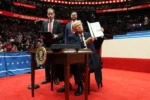A recent ruling by a federal judge has put a stop to a significant change proposed by the Trump administration that would affect transgender medical care. U.S. District Judge Lauren King, appointed by President Joe Biden, made this decision in Seattle after three states and doctors filed a lawsuit against the government. They argued that the executive order aimed at banning federal support for medical services for transgender youth could hurt many important health programs. This judge’s action means that the government cannot cut funds for medical institutions, which is crucial for the well-being of countless patients.
| Category | Details |
|---|---|
| Judge | U.S. District Judge Lauren King, appointed by Joe Biden. |
| Location | Seattle, Washington |
| Lawsuit Filed By | Three states and three doctors against the government on February 7. |
| Executive Order Number | Executive Order 14187 |
| Main Focus of Executive Order | To eliminate federal funding for transgender medical care for individuals under 19. |
| Key Arguments Against the Order | 1. Unconstitutional usurpation of Congressional spending power. 2. Threat to cut federal funds harming unrelated medical services. |
| Impact of Fund Cuts | Over one billion dollars in federal assistance at risk, affecting various medical services. |
| Temporary Restraining Order | Bars approximately 11 federal agencies from cutting off funds related to transgender care. |
| Additional Provisions Blocked | Law enforcement provisions regarding female genital mutilation and compliance enforcement. |
| Judge’s Expectation | Judge King will clarify her reasoning in a future opinion; order lasts until February 28 unless extended. |
Understanding the Temporary Restraining Order
A temporary restraining order is a legal tool that can stop actions from being taken until a case is fully resolved. In this situation, U.S. District Judge Lauren King issued a temporary restraining order to block parts of an executive order from the Trump administration. This means that the federal government cannot cut funding for transgender medical care in certain states while the lawsuit is being considered. The order is crucial because it protects important medical services for transgender youth.
The judge’s decision came after a lawsuit was filed by three states and doctors who serve transgender youth. They argued that the executive order was unfair and unconstitutional. By pausing the order, Judge King ensures that these medical facilities can continue to receive federal funding. This funding is essential for providing care not only for transgender issues but also for many other health conditions. The temporary restraining order will last until February 28, unless further action is taken.
The Impact of Executive Order 14187
Executive Order 14187 was aimed at banning federal support for transgender medical care, claiming to protect children from what it referred to as ‘chemical and surgical mutilation.’ However, many experts and advocates argue that this order misunderstands medical practices for transgender youth. The lawsuit highlights that essential treatments like hormone therapy and puberty blockers are not surgeries, but rather necessary medical care for those undergoing gender transition.
The implications of this executive order could be severe, as cutting funding would affect more than just transgender medical care. It could limit resources for a variety of medical services, jeopardizing over one billion dollars in federal assistance in the plaintiff states. This funding helps hospitals and medical schools treat many health issues, such as cancer and mental health disorders. Thus, the executive order is seen as potentially harmful, not just for transgender patients, but for all patients relying on these vital services.
The Legal Arguments Against the Executive Order
The lawsuit against the Trump administration’s executive order centers on claims that the order is unconstitutional. Plaintiffs argue that it unlawfully tries to change how Congress allocates federal funds by imposing new conditions. They believe this is a misuse of power, as the government should not be able to limit funds based on specific medical practices. By halting the executive order, the court aims to protect the balance of power between the legislative and executive branches.
Additionally, the lawsuit asserts that the order threatens to criminalize healthcare providers who offer gender-affirming care. This creates fear among these professionals and could discourage them from providing necessary treatments. The plaintiffs stress that no transgender minors undergo gender-affirming genital surgery, yet the executive order attempts to label other non-surgical treatments as ‘mutilation.’ This misrepresentation could lead to dangerous consequences for medical providers and patients alike.
The Implications of the Temporary Restraining Order
The temporary restraining order issued by Judge Lauren King marks a significant moment for transgender rights and medical care. By blocking the enforcement of parts of Executive Order 14187, this ruling presents a critical opportunity for states and healthcare providers to continue offering vital services without fear of federal repercussions. This decision underscores the judiciary’s role in protecting individual rights and maintaining checks and balances against executive overreach.
Moreover, the ruling emphasizes the potentially harmful consequences of cutting federal funding for medical institutions serving transgender youth. The plaintiffs highlighted that not only would such actions disrupt gender-affirming care, but they could also jeopardize essential funding for various non-transgender-related medical services. This broader scope of impact reveals how far-reaching the implications of the executive order could be, affecting healthcare outcomes for countless individuals.
Understanding the Legal Arguments Against the Executive Order
The lawsuit against the Trump administration’s executive order centers on significant constitutional issues, including the separation of powers and Congress’s spending authority. The plaintiffs argue that the executive order unlawfully attempts to impose conditions on appropriated funds, essentially altering congressional intent. This aspect of the case highlights the importance of legislative processes and how such executive actions can undermine established legal principles.
Additionally, the plaintiffs assert that the executive order’s attempts to redefine non-surgical gender-affirming treatments as ‘mutilation’ are not only misleading but also legally unfounded. This argument challenges the very basis of the order, suggesting that it misuses existing laws to create fear and discourage healthcare providers from offering necessary care. Such tactics raise serious ethical concerns and question the integrity of healthcare policies aimed at vulnerable populations.
The Broader Context of Transgender Healthcare Policies
The ongoing legal battles surrounding transgender healthcare reflect a larger national conversation about gender identity and medical rights. As more states consider legislation that impacts transgender individuals, this ruling may influence future policies and legal interpretations across the country. The temporary restraining order serves as a reminder of the importance of judicial intervention in protecting marginalized communities from discriminatory practices.
Furthermore, the discussion around transgender healthcare is not just about policy; it encompasses the rights and well-being of individuals seeking medical care. The stakes are high, as the ability to access gender-affirming treatments can significantly affect the mental and emotional health of transgender youth. This ruling aids in reinforcing the notion that healthcare should be accessible and free from politicization, ensuring that medical decisions remain between patients and their healthcare providers.
Future Considerations for Transgender Rights and Healthcare
Looking ahead, the temporary restraining order opens the door for further legal scrutiny of executive actions affecting healthcare for transgender individuals. As the case progresses, the judiciary may set crucial precedents that could reshape the landscape of transgender rights and healthcare access. Legal experts and advocates will closely monitor these developments, as they could have lasting implications for future administrations and their approach to similar issues.
Additionally, this ruling highlights the need for continued advocacy and support for transgender individuals within the healthcare system. As the legal challenges unfold, it is vital for policymakers, healthcare providers, and community organizations to work together to ensure that all individuals receive equitable treatment. The ongoing dialogue around transgender healthcare must prioritize the voices and experiences of those directly affected, fostering an inclusive environment that champions patient rights.
Frequently Asked Questions
What did the federal judge do about the transgender medical care ban?
The federal judge paused the Trump administration’s ban on federal support for transgender medical care. This means that the federal government cannot stop funding for these services while the case is being decided.
Why did some states and doctors sue the Trump administration?
They sued because they believed the ban was unfair and could hurt many medical services, not just those for transgender people. They argued it violated the Constitution.
What is Executive Order 14187 about?
Executive Order 14187 aimed to stop federal funding for medical care related to transgender youth. It was intended to protect children from what the order called ‘chemical and surgical mutilation’.
How could the ban affect medical funding in the states involved?
The ban could take away over one billion dollars in federal funds. This money helps medical schools and hospitals treat many conditions, like cancer and diabetes, not just gender-related issues.
What does the lawsuit say about the treatments for transgender minors?
The lawsuit claims that transgender minors do not undergo surgery for gender transition. Instead, it focuses on treatments like puberty blockers and hormone therapy, which the order wrongly labels as ‘mutilation’.
What is the role of the temporary restraining order issued by the judge?
The temporary restraining order stops the federal government from enforcing the ban for now. It protects access to transgender medical care until the court makes a final decision.
Why is the executive order controversial?
The executive order is controversial because it tries to redefine important medical treatments as harmful. Many believe this is an attempt to scare doctors and limit care for transgender youth.
Summary
A federal judge has temporarily halted the Trump administration’s attempt to ban federal support for transgender medical care, issuing a restraining order in favor of three states and doctors who filed a lawsuit. The plaintiffs argue that the executive order threatens funding essential for various medical services and represents an unconstitutional use of power. The order sought to redefine non-surgical treatments for transgender minors as ‘mutilation,’ instilling fear among healthcare providers. The judge’s ruling prevents enforcement of the order’s provisions until further clarification is provided, with the restraining order effective until February 28.







